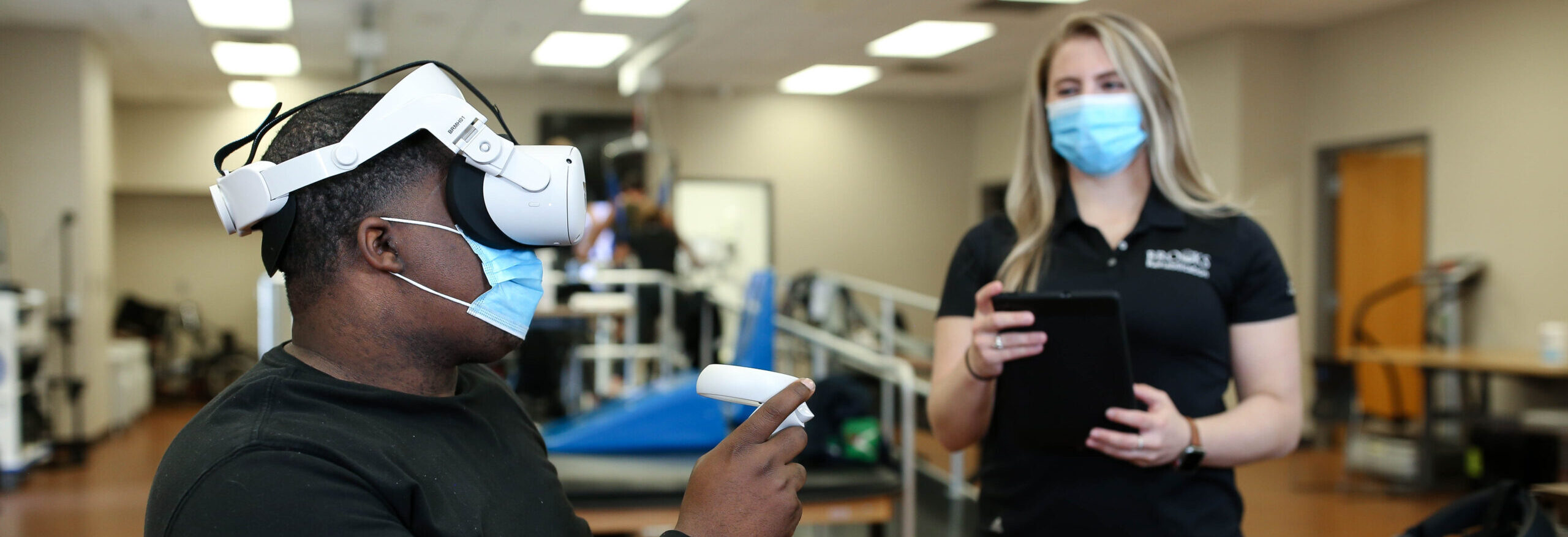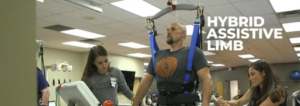Virtual Reality Driving Real World Results

Back to physical health resource hub
The patient finds himself holding two small bats, one in each hand. One bat is blue, the other red. He’s facing a small cannon – like a batting machine – and he hears it winding up for the pitch. Out comes a ball – this time it’s blue, so he has to hit it with the blue bat. Pitch after pitch comes, red or blue, testing the patient’s ability to react and reach, as well as his range of motion. Is this happening in some sandlot outside? No – the patient is comfortably inside, wearing a virtual reality (VR) headset, all under the watchful eye of his therapist, who is controlling, monitoring and measuring everything from a tablet. VR is the next big thing in rehabilitation, and Brooks is at the forefront.
Leading the way for Brooks is Jeffery Porter, PTA, Coordinator of Education at Halifax Health | Brooks Rehabilitation Center for Inpatient Rehabilitation in Daytona Beach, Fla. A self-described “kind of a big nerd,” Porter has a background in technology that stretches back to developing his own online video games as a kid. It was during a 2019 residency in Brooks’ Home Health division that he came up with the idea for an emergency button for the home patients – and Brooks Belle, the push-button access to help, was born.
Since then, Porter has been working with Bob McIver, PT, DPT, NCS, director of Brooks Clinical Technology and Wellness Programming. “The purpose of virtual reality is that we can create things that are non-existent, and we can have tons of repetition, which is all part of neuroplasticity (the brain’s ability to modify in response to experience). I can have that patient focus on one thing 1,000 times,” said Porter. “In virtual reality, you have thousands of reps, and you get to see where you’re missing and where you’re successful, and you see progress in the virtual world because it’s all mapped out.”
Porter develops new VR applications in conjunction with Veera Engineers, a Dayton, Ohio-based firm of engineers, artists, and programmers with the mission to “build people, create value and enrich lives through engineering consulting with modern technology.” Brooks uses Oculus Quest 2 headsets from Reality Labs, a business of Meta Platforms (formerly Facebook), with the Brooks therapist controlling the Veera-developed software on Android devices.
Porter even goes into virtual reality himself to meet with Veera Engineers, where he’ll explain the next new “game” he’s looking for, draw it in 3D, discuss expectations and exactly what the engineers will need from him to create the product. For example, early on Porter had to explain range of motion and range of motion zones. But once all the prep work is done, Veera can create a brand-new application in a matter of weeks, depending on their capacity.
Porter said, “Eventually, we’ll be catching baseballs, or we’ll be blocking soccer balls, or doing something that considers all the fundamentals, such as the GH, the Glenohumeral range of motion. We can track that. So, if a patient is successful hitting this way, but not successful hitting a different way, we’re tracking that, so that way we can challenge them. And we’re using AI (artificial intelligence) to dynamically challenge a patient to reach in areas they may not be able to do now; or are fearful of trying or even they currently can’t see. There’s no limit to VR. We can help train their vision. We can work on cardiovascular and train their endurance. We can train a little bit of everything.”
There are currently four Brooks sites with VR capabilities – including with Porter at Halifax Health | Brooks Rehabilitation and the Neuro Recovery Center (NRC) at Brooks Rehabilitation Hospital – University Campus. Each of the four locations has teams working to create VR applications with Veera, based off of the needs for the patients. Even patients provide feedback and recommendations, like a driving simulator. Going forward, Brooks and Veera will look to expand the number of applications and create a more high-quality product. Porter says the ultimate goal is to have VR capabilities at all outpatient clinics, connecting them all into a Brooks mini-metaverse.


